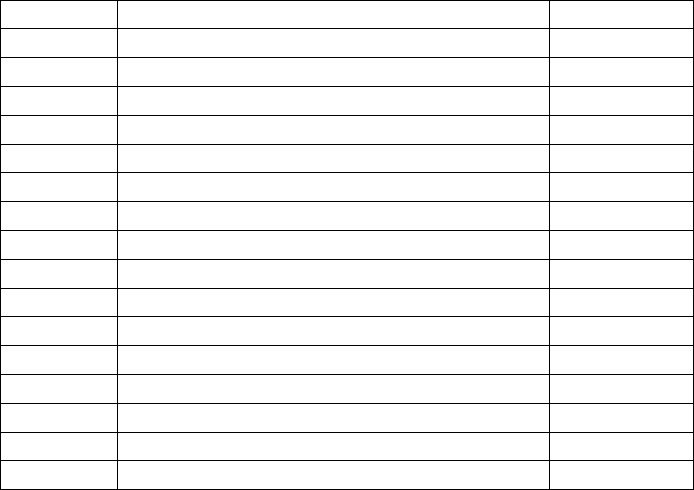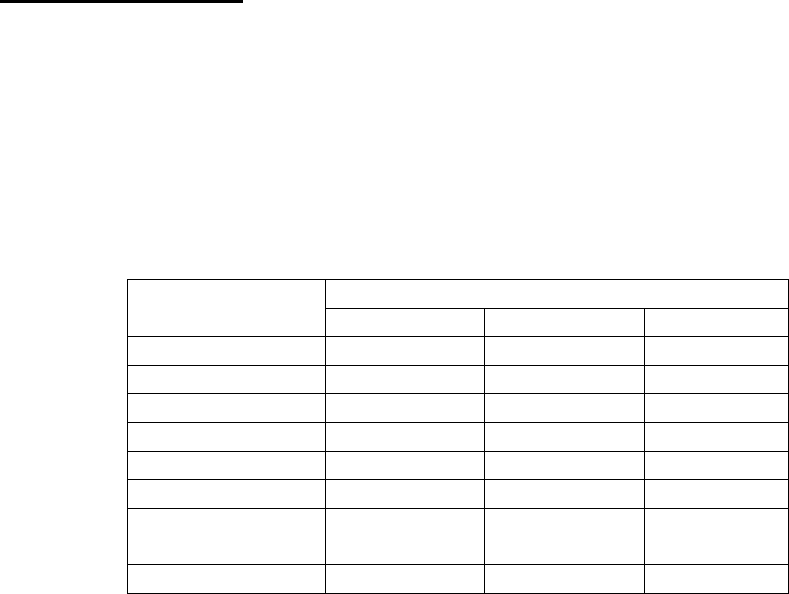
1
_________________________________________________________
Academic Program Review
Bachelor of Science in Microbiology
September 2018
_________________________________________________________
School: School of Arts and Sciences
Department: Basic and Clinical Sciences
Dean & Chair: David Clarke, PhD
Program Director: Meenakshi Malik, PhD
2
TABLE OF CONTENTS
I. Introduction 3
II. Program History 5
III. Program Mission, Goals and Objectives 6
IV. Program Design 6
V. Dual Degree BS Microbiology/MS Molecular Biosciences 10
VI. Recruiting and Admissions 12
VII. Student Profiles 13
VIII. Faculty Profiles 15
IX. Resources and Facilities 21
X. Program Support 23
XI. Program Capacity & Growth 24
XII. Program Assessment & Outcomes 25
XIII. Conclusions and Recommendations 31

3
I. INTRODUCTION
Microbiologists investigate the growth and characteristics of microscopic organisms such as bacteria,
parasites or fungi. Biomedical Microbiology involves the study of bacteria (bacteriology) viruses
(virology), and immunology (the study of mechanisms to fight infections). Medical microbiologists
are needed to detect and study pathogenic microbes which cause disease in humans, pets, livestock,
wildlife, and plants as well as develop vaccines and treatments for new, emerging and re-emerging
diseases. Microbiologists will also be required to combat the threat of bioterrorism and the growing
concern of antimicrobial resistant pathogens. More generally, well-trained microbiologists are also
needed to maintain quality control standards for microbial contamination of drugs, food, medical
devices, and water; and produce therapeutic and other commercially important proteins in recombinant
microbes for the biotechnology industry. Due to these pressing societal needs, significant interest and
demand will continue to exist for Microbiology majors.
Its specialized focus on biomedical sciences puts ACPHS in a strong position to offer an undergraduate
degree program in Microbiology. The goal of the BS Microbiology (BSMB) program at Albany
College of Pharmacy and Health Sciences is to prepare its graduates for employment or advanced
study in fields requiring knowledge of microbial life, e.g., health care, public health, biotechnology,
pharmaceutical sciences, medical equipment and supplies industry (Section III). Following completion
of foundational courses, students can elect specific tracks which match their goals for each of these
varied employment and educational opportunities in consultation with the faculty advisors within the
department.
The program has three tracks that allow students to specialize in Biomedical Microbiology, Public
Health Microbiology/Infectious Disease Epidemiology, or Industrial/Pharmaceutical Microbiology.
The first two of these tracks are fully implemented. The College intends to begin offering the
Industrial/Pharmaceutical Microbiology track in the 2019-2020 academic year. All three tracks in the
program abide by the core curriculum guidelines of the American Society for Microbiology (ASM)
for the baccalaureate degree program in microbiology. The following is a brief description of each of
the three tracks of BSMB program along with the career objectives:
Biomedical Microbiology track educates graduates in understanding how infectious diseases occur. It
serves as the foundation for advanced graduate studies in Microbiology, Immunology, Virology, and
Cell & Molecular Biology. Graduates are prepared for entry into the professional schools such as
medicine, veterinary, dental, and public health. Graduates also find jobs as research technicians in
laboratories working in the area of microbiology and infectious diseases.
Public Health Microbiology/Infectious Disease Epidemiology track offers instruction on the public
health impact of infectious diseases. It educates graduates in concepts, methods, and application of
epidemiological principles related to infectious diseases. Graduates of the program have an in-depth
understanding of the major laboratory and public health aspects of microbial pathogens. They gain
epidemiologic skills relevant to the prevention and control of problems arising from infectious
diseases. Graduates are prepared for careers in academic and industrial research laboratories,
international health agencies, nongovernmental organizations and private consulting groups. In
addition, they may work in federal, state and local public health agencies or state and local public

4
health laboratories where their technical expertise and population-based perspective is extremely
useful.
Industrial/Pharmaceutical Microbiology track will prepare the students for the scientific principles,
techniques and skills required in industrial microbiology. Specialized study will include biotechnology
applications, biochemistry, analytical chemistry and pharmaceutical microbiology. This track will
educate students in the areas of microbial contamination prevention, investigation, quality control and
quality assurance, and aseptic processing. Students will gain experience in pharmaceutical processing
and manufacturing and healthcare issues. Graduates will acquire skills required for quality control of
raw materials and finished products, knowledge in drug and environmental regulations and guidelines
along with learning the principles of Good Manufacturing Practices (GMP).
The BSMB program is a newer program offered by the Department of Basic and Clinical Sciences
within the School of Arts and Sciences at ACPHS. Eleven students have graduated from the program
in the last three years while 33 students are currently enrolled. The ultimate target number of students
is 20 per year for a total of ~80 students in the program.
The curriculum of BSMB program was developed in accordance with the latest guidelines released by
the ASM for Undergraduate Microbiology Majors in 2012, the same year this program was created
(Section IV). Hands-on laboratory skills and research opportunities provide the foundation for the
program. Students have the ability to be engaged in laboratory-based independent research projects
beginning in their first year, working side-by-side with faculty whose expertise has attracted funding
from various sources including the federal government. Student research experiences have spanned
many types of projects that capitalize on faculty strengths in bacteriology, virology, immunology, and
cell biology.
Since implementation in Fall of 2013, BSMB has undergone a few minor revisions to enhance the
student experience, accommodate students’ needs, better meet the program objectives, and to better
foster development of scientific literacy and critical thinking skills (Section IV). The recently
approved joint Bachelor’s in Microbiology/Master’s degree in Molecular Biosciences program (first
class enrolled for Fall of 2018) has led to enhanced academic offerings and research opportunities,
allowing students to earn both bachelor’s and master’s degrees in five years (Section V).
The program is adequately resourced in terms of faculty, laboratory space, and equipment. The core
faculty in the program maintain active research programs, mentor undergraduate and graduate
students, and seek to implement innovative pedagogies. Further information regarding faculty profiles,
training, and demographics may be found in Section VIII. ACPHS currently has approximately 16,000
ft
2
of research and instructional laboratory space containing all the equipment required to carry out
cutting-edge research in Biomedical Sciences. Further details of the facilities, resources and equipment
can be found in Section IX.
Program students are supported primarily at the department level interacting regularly with the
Program Director and Core Program Faculty. Additional support is provided by the Center for Student
Success, which includes a variety of academic support, advising, and career services. Details of this,
and other student support functions on campus, can be found in Section X.

5
The program places strong emphasis on post-graduate career outcomes. Almost all of the BSMB
graduates have gone on to graduate or professional schools or post-baccalaureate careers in healthcare
or biopharmaceutical industry. Section XII include details of the assessment of Program and Student
Learning Outcomes.
II. PROGRAM HISTORY
A. Program Context
Albany College of Pharmacy and Health Sciences (founded 1881) is New York State’s oldest
pharmacy school. It is a private, not-for-profit educational institution with a 30-acre, eight-building
main campus in Albany, NY, satellite campus in Colchester, VT, and the Pharmaceutical Research
Institute (PRI) building in Rensselaer, NY, with a total of 1,400 students enrolled in all programs. The
College offers a Doctor of Pharmacy (Pharm.D.) and four-year Bachelor of Science degrees in
Microbiology, Pharmaceutical Sciences, Public Health, Biomedical Technology, and Clinical
Laboratory Sciences. ACPHS also offers Master’s of Science degrees in Molecular Biosciences,
Pharmaceutical Sciences, Cytotechnology and Molecular Cytology, Health Outcomes Research, and
Clinical Laboratory Sciences.
The BSMB program at ACPHS is particularly geared towards medical, pharmaceutical and public
health microbiology. A combination of basic science, with clinical and translational research, provides
ACPHS a unique niche not found in many other institutions. There are very few institutions in the
entire Northeast that offer a BS in Microbiology degree and none are in the Capital region. The only
institution in New York State that currently offers a BS in Microbiology degree is Wagner College
which is a liberal arts college and does not have a strong focus on Medical Microbiology.
The program was developed after performing a significant needs analysis on job outlook, salaries and
other programs offering the major, nationally and regionally, for the decade of 2010-2020. The
findings of the analysis performed in 2012 are provided in Appendix A. According to the United States
Department of Labor, the total employment of microbiologists in the next decade (2016-2026) is
projected to grow at 8% over the 2010-2020 decade, about as fast as the average of all occupations.
With the current and projected need for microbiologists in basic research and the biopharmaceutical
industry, and an average median pay of $69,960 annually (2017 data), we expect that significant
interest and demand will continue to exist for Microbiology majors.
B. Implementation Timeline
May 2012
New York State Approval (HEGIS Code 0411)
July 2012
Recruitment began for first and second year students
August 2013
First class enrolled
May 2016
First class graduated (4 students)
May 2017
Second class graduated (4 students)
May 2018
Third class graduated (3 students)

6
III. PROGRAM MISSION, GOALS & OBJECTIVES
A. Mission
To provide outstanding education and training to undergraduate students in the theoretical knowledge
and laboratory skills of microbiology relevant to human health.
B. Goals
The goal of the BSMB program at Albany College of Pharmacy and Health Sciences is to prepare its
graduates for employment or advanced study in fields requiring knowledge of microbial life, e.g.,
health care, public health, biotechnology, pharmaceutical industry, academic and government sectors.
C. Objectives
All graduates of the program are expected to fully integrate the theoretical knowledge and laboratory
skills of microbiology along with developing scientific reasoning, critical thinking, and
communication skills. They are expected to:
1. demonstrate a working knowledge of traditional and emerging areas of microbiology
2. obtain, interpret, and apply information about microbiology from the scientific literature
3. integrate and apply knowledge to solve complex scientific problems.
4. formulate hypotheses to explain research problems and demonstrate an understanding of the
facilities and expertise necessary for testing these hypotheses
5. possess appropriate laboratory skills including the ability to observe and record results, work
safely, self-organize and manage one’s time.
6. effectively communicate scientific information both orally and in writing
7. work both independently and collaboratively in scientific processes
8. understand their ethical and professional responsibilities and be aware of the contemporary
societal and global issues facing scientists.
IV. PROGRAM DESIGN
Our Bachelor's in Microbiology (BSMB) program has been designed according to the guidelines
published by ASM for Undergraduate Majors (Appendix B) to include both the coursework and hands-
on laboratory and research experiences required to succeed in this dynamic field. The result is a degree
that serves as a springboard to Master’s or PhD-level programs, medical school, or entry-level
positions in academic and government laboratories, or the biopharmaceutical industries.
Degree requirements for the BSMB program include completion of both required and elective
coursework. Depending on the student’s track, the number of total credits needed for completion of
the degree is 122-124 credits. All students in the program are required to complete 39 credits of Basic
Science courses, 14 credits of Humanities and Communication courses, 33 credits of Microbiology
core courses, 14-16 credits of track specific courses, and 21 credits of free electives. Specifics of the
BSMB Curriculum are detailed below. Sample schedules for the last five years can be found both in
the ACPHS College Catalog and Appendix C.

7
A. Curriculum
All students, regardless of track selected, complete the following core curriculum. Students will be
required to complete one of the tracks described below. Each track contains 9-11 credits of required
courses. Students must also choose 5-6 credits from a list of approved track electives.
CORE CURRICULUM
BASIC SCIENCES: 39 REQUIRED CREDITS
BIO 101 and 102: General Biology I and II (4, 4)
CHE 101 and CHE 102: General Chemistry I and II (4, 4)
CHE 211 and 221: Organic Chemistry I and II (4, 4)
PHY 212 and 222: College Physics I and II (4, 4)
MAT 121: Calculus I (4)
MAT 145: Elementary Statistics (3)
HUMANITIES AND COMMUNICATIONS: 14 REQUIRED CREDITS
HUM 101, 102 and 201: Pre-Modern World (3), Modern World (3), Contemporary World (3)
COM 115: Principles of Communication (3)
BIO 253: Scientific Communications (2) [or other comparable course]
MICROBIOLOGY: 33 REQUIRED CREDITS
BIO 210: Microbiology (4)
PSC 315: Immunology (3)
PSC 311: Biochemistry (3)
BIO 235: Cell Biology (3)
BIO 340: Microbial Genetics (3)
BIO 370: Microbial Physiology (3)
BIO 350 and 355: Biomedical Laboratory Techniques I and II (3, 3)
BIO 660G: Microbiology Journal Club (1+1) – course is taken twice
BIO 480 and BIO 485: Microbiology Capstone Experience I and II (3, 3)
Options for Microbiology Capstone Experience - Research (a minimum of 3 credits),
Internships, and/or Independent Projects. The plan for the Capstone Experience should be
developed by the student in conjunction with the faculty adviser and Program Director and
approved in spring of the Junior Year.
ELECTIVES: 21 CREDITS
At least 9 credits must be in the humanities or social sciences.
TRACK CURRICULUM
BIOMEDICAL MICROBIOLOGY TRACK
BIO 680G: Bacterial Pathogenesis (3)
BIO 240: Virology (3)
BIO 365: Medical Mycology and Parasitology (3)

8
A minimum of 5 credits chosen from BIO 225: Genetics (3), BIO 213: Anatomy &
Physiology I (3), BIO 215: Anatomy & Physiology II (3), ETH 310: Bioethics (3), BIO
240: Virology (3), BIO 365: Medical Mycology and Parasitology (3), PSC 321:
Physiology/Pathophysiology I (3), PSC 322 Physiology/Pathophysiology II (3), BIO
625G: Advanced Molecular Biology (3), BIO 630G: Advanced Cell Biology (3), BHS
745G: Molecular Diagnostics (3), BIO 620G: Advanced Topics in Microbiology (3).
Other courses may be counted at the discretion of the Program Director.
PUBLIC HEALTH/INFECTIOUS DISEASE EPIDEMIOLOGY TRACK
PAD 393: Introduction to Epidemiology (3)
BIO 315: Public Health Microbiology (3)
PBH 330: Global Perspectives in Epidemiology (3)
A minimum of 5 credits chosen from SOC 120: Introduction to Public Health (3), PSC
432: Infectious Disease Pharmacology (3), ETH 310: Bioethics (3), HRI 600G: Issues in
Global Health (3), PHM 350: Applied Methods in Epidemiological Research (3), BIO
270: Public Health Toxicology (3), PBH 360: Field Epidemiology (3), HRI 646G:
Epidemiology II (3). Other courses may be counted at the discretion of the Program
Director.
INDUSTRIAL/PHARMACEUTICAL MICROBIOLOGY TRACK
BIO 360: Industrial Microbiology and Bioprocessing (3)
BIO260: Public Health Toxicology
BIO 410: Pharmaceutical Microbiology (3)
A minimum of 5 credits chosen from PSC 341: Pharmaceutics I (3), PSC 342:
Pharmaceutics II (3), CHE 375: Analytical Chemistry I (4), CHE 380: Analytical
Chemistry II (4), BIO 455: Toxicology (3), SOC 335: Public and Health Policy (3). Other
courses may be counted at the discretion of the Program Director.
TOTAL CREDITS: 122-124 CREDITS
B. Curriculum Mapping to Program Objectives
Goals and Objectives for the BSMB program (as described in Section III) may be broken down into
both the General Education/General Abilities Objectives and the BSMB-specific Program Objectives.
The General Education program at ACPHS supports the mission of the College to instill values,
attitudes and skills that enable lifelong intellectual, cultural, personal and professional growth. The
General Ability Based Outcomes are primarily met during the student’s first two years in the program
(details provided in Appendix D). These include the basic sciences, humanities, liberal arts, and
communications courses and are housed within various departments in the School of Arts and
Sciences. These courses expand the student’s historical, cultural, literary, scientific and philosophical
perspectives. They also foster the critical assessment of ethical and humanistic values, and emphasize
the communication, critical thinking and problem-solving skills that prepare the student to advance in
their professional discipline and cultural competency. Through its blend of required and elective

9
courses, the College strives to expose students to the complexities of the world and prepare them to
become valuable participants. The School of Arts and Sciences is currently in the midst of mapping
the General Education courses offered in the first two years to the General Ability Based Outcomes as
detailed in Appendix D. The results of this exercise are expected by Fall 2018.
The BSMB program at ACPHS has specific programmatic objectives (Section III) which foster
theoretical and lab-based scientific skills, critical thinking, and communication skills in order to help
students achieve their career goals. Courses are aligned and sequenced in a manner to build upon a
student’s knowledge and continually introduce developing topics in Microbiology. As the
Microbiology field relies on basic science premises, the first two years of the curriculum are heavily
weighted with math and science courses (e.g. Calculus, Chemistry, and Biology) which build the
groundwork for future student development in various specialties within Microbiology (e.g.
Biomedical Microbiology or Public Health Microbiology/Infectious Disease Epidemiology). The
overall Programmatic Objectives have been mapped to the courses in the curriculum and are presented
in Appendix E.
There are currently no national accreditation standards for benchmarking the BS Microbiology
program. However, in an effort to provide guidance in the education of undergraduate students in
microbiology, the American Society for Microbiology (ASM) has developed a set of curriculum
guidelines for microbiology majors (Appendix B). According to ASM, the guidelines are not meant
to be a set of criteria for accreditation of a program. Rather they are meant to be used by programs in
their own assessment, maintenance, and formation of strong programs in microbiology. Appendix F
provides a summary of courses offered in BS Microbiology program at ACPHS in comparison to ASM
curriculum recommendations for undergraduate majors. The ASM task force also updated the
Curriculum Guidelines for Undergraduate Microbiology Education in 2012 and identified key
concepts and skills that are (i) central to microbiology and (ii) useful to define curriculum learning
goals for general microbiology. These key concepts and skills identified by the Task Force have been
mapped to the topics covered in core courses of the curriculum (Appendix F). With the exception of
Microbial Ecology and Diversity, the BSMB curriculum is meeting all the ASM recommendations.
Although some topics are discussed in General Biology and Microbiology courses, a course in this
area would strengthen the curriculum.
Almost all of the required courses in the Program are taught by the core Microbiology faculty
members. However, some track-specific courses are offered by other departments at the College.
Department of Population Health Sciences (DPH) housed within the School of Arts and Sciences
offers a BS in Public Health Program. DPH offers several courses in Public Health including
Introduction to Public Health and Global Perspectives in Epidemiology that students in the BSMB
program take advantage of. A few other courses including Epidemiology I and Applied Methods in
Epidemiological Principles are offered by the Department of Pharmacy Practice within the School of
Pharmacy and Pharmaceutical Sciences. These offerings satisfy core and elective requirements of the
Public Health Microbiology/Infectious Disease Epidemiology Track within the BSMB program.
C. Curriculum Revisions
There have been some minor curriculum revisions undertaken since the creation of BSMB program in
2013 (Appendix G).
10
1. A free elective was added to the curriculum to replace previous courses (Seminar in Health
Professions, Introduction to Laboratory Data) with a credit-to-credit swap. This brought the
total number of free electives requirement to 21 credits.
2. A two semester Journal Club was added as a required co-requisite course for all Senior Year
students enrolled in Microbiology Capstone Experience I and II courses to further improve
their scientific thinking and communication skills.
3. The next revision was made after several elective courses offered by the DPH were
discontinued. This necessitated new elective offerings by DPH and BCS, some of which were
taught by new faculty hired recently in both the departments. Some of these additional courses
included Introduction to Public Health, Public Health Microbiology, Global Perspectives in
Epidemiology, and Public Health Toxicology.
4. To eliminate content redundancies in the current curriculum, a revision was made last year to
eliminate the Molecular Biology course and replace it with a new course Medical Mycology
and Parasitology (for Biomedical Track) or Cell Biology course (for the other two tracks). The
reason for this change was that Molecular Biology which covers both prokaryotic and
eukaryotic genetics overlapped significantly with Microbial Genetics especially, in the topics
related to prokaryotic molecular biology. Furthermore, Cell Biology (a required course for
Biomedical track) covered the remaining topics (eukaryotic biology) that were taught in
Molecular Biology.
5. Since the creation and approval of a joint degree program in BS Microbiology and MS
Molecular Biosciences last year (details provided in Section V), we have added several
graduate level courses that could be taken by BSMB Senior Year students who are also First
Year graduate students. Some of these courses that can serve as Required Track courses include
Advanced Molecular Biology, Advanced Cell Biology and Advanced Topics in Microbiology.
These curriculum revisions were done to enhance the student experience, fit the student’s needs, better
meet the program objectives, and to foster development of scientific literacy and critical thinking skills
in order to better prepare the student to perform a hypothesis-based research project as a capstone to
their BSMB degree.
V. DUAL DEGREE: BS MICROBIOLOGY/ MS MOLECULAR BIOSCIENCES
The dual BS/MS degree program provides students enrolled in the Bachelor of Science program in
Microbiology the opportunity to concurrently pursue the Master of Science degree in Molecular
Biosciences, beginning in the fourth year of their undergraduate program, and complete both degrees
in five years. This dual degree program reduces the total number of courses needed and the total time
required for completion of both the BS and MS degrees. As with other combined degree programs at
ACPHS, both the BS and the MS degrees are awarded upon completion of the MS degree. Students
enrolled in the BSMB program apply to the School of Graduate Studies in their third (junior) year
according to established procedures and deadlines of the School of Graduate Studies. Students are
expected to have a cumulative GPA of 3.0/4.0 at the time of application. The GRE is not required for
applicants with cumulative GPAs of 3.0 or higher. In order to complete the dual degree program in
five years, students are expected to utilize two summers (between 3
rd
and 4
th
year and between 4
th
and
5
th
year) to complete their master’s thesis research project.

11
The dual BS, Microbiology/MS, Molecular Biosciences degree program has a total of 146 credits, 113
undergraduate credits and 33 graduate credits, with 9 graduate credits that are counted toward both
degrees. Students completing this program are trained as scientists in the basic mechanisms of human
health and disease, with emphasis on infectious disease. The program is interdisciplinary, bringing
together basic, applied, and clinical scientists from a number of departments to provide students with
individualized, cutting-edge biomedical research training and foundational coursework. The BS
courses in the program are designed to provide students with a strong didactic foundation in the
biomedical sciences, with emphasis on microbiology and infectious diseases, and couples this
foundation with early exposure to biomedical research. This allows the students to progress into the
advanced courses and research experiences in the MS, Molecular Biosciences program on an
accelerated timeline. Students are expected to choose a BS capstone topic in consultation with MS
Molecular Biosciences faculty so that the capstone research can be expanded to a Master’s thesis. It is
expected that Research Rotation (BIO670G- Graduate) and Capstone Experience (BIO480/485-
Undergraduate) in the Fourth year of Undergraduate/First Year of Graduate study run concurrently
under one Faculty mentor (5 credits of total time- 3 credits for Capstone and 2 credits of Research
Rotation). Research areas encompass a broad range of disciplines including molecular genetics, cell
biology, biochemistry, pathophysiology, microbiology, immunology, and infectious diseases.
Research is further supported with courses in the core biomedical disciplines, laboratory research
techniques, ethical conduct of science, and a graduate seminar course. A major requirement for
program is the completion of original research and the publication of a thesis describing that research.
The program emphasizes the importance of high quality research, and is designed to assist students in
fulfilling their potential as research scientists. This dual degree program provides graduates with a
competitive advantage in applying to PhD programs, professional schools of medicine and dentistry
as well as positions in biotechnology and pharmaceutical companies. Given below is the Program of
Study for students enrolled in the dual degree. A sample schedule is provided in Appendix H.
The enrollment in this dual degree program will start in Fall 2018.
Dual Degree (BS Microbiology/MS Molecular Biosciences) Curriculum (2018-2019)
CODE
COURSE NAME
CREDITS
BIO 101
General Biology I
4
CHE 101
CHE 101: General Chemistry I
4
HUM 101
HUM 101: Pre-Modern World
3
MAT 121
Calculus I
4
BIO 102
General Biology II
4
CHE 102
General Chemistry II
4
HUM 102
Modern World
3
COM 115
Principles of Communication
3
CHE 201
Organic Chemistry I
4
PHY 212
College Physics I
4
BIO 210
Microbiology
4
HUM 201
Contemporary World
3
CHE 253
Scientific Communications
2
CHE 202
Organic Chemistry II
4
PHY 222
College Physics II
4
MAT 145
Elementary Statistics
3

12
BIO 240
Virology
3
PSC 315
Immunology
3
PSC 311
Biochemistry
3
BIO 370
Microbial Physiology
3
BIO 350
Biomedical Lab Techniques I
3
BIO 365
Medical Mycology & Parasitology
anMycology
3
BIO 340
Microbial Genetics
3
BIO 355
Biomedical Lab Techniques II
3
BIO 325
Cell Biology
3
BIO 480
Microbiology Capstone Experience I
3
MAT
610G
Statistical Inference and Modeling
3
BIO 625G
Advanced Molecular Biology
3
BIO 670G
Research Rotation
2
---
UG Electives
21
BIO 660G
Molecular Biosciences Journal Club
3
BIO 485
Microbiology Capstone Experience II
3
BIO 650
655G
Research Design
2
BIO 630G
Advanced Cell Biology
3
BIO 645G
Bacterial Pathogenesis
3
ETH
610G
Ethics in Research
1
---
Graduate Electives
9
BIO 701G
BIO701G: Thesis Research
6
TOTAL (UNDERGRADUATE)
113
TOTAL (GRADUATE)
33
TOTAL
146
VI. RECRUITING & ADMISSIONS
The Office of Admissions within the Enrollment Management Department recruits students (first-time
freshman and transfer students to the first, second, and third year entry points) to the Bachelor of
Science in Microbiology in accordance with the College Academic Admissions Policies (Appendix I).
In consultation with the department and Program Director, the Admissions Office develops an annual
recruitment plan that includes lead acquisitions from higher education vendors such as the College
Board, digital/print marketing collateral, visits to high schools/community colleges, and on-campus
visit programming. Program faculty communicate with prospective students during campus visits,
have laboratory demonstrations with Q&A sessions about the program in-person and via phone/email
outreach.
Enrollment numbers in the BSMB program since inception are given in the table on the following
page. A total of 33 students are enrolled in the program currently. The ultimate target number of
students is 20 per year for a total of ~80 students in the program. The detailed enrollment numbers in
required and elective courses for the last five years is provided in Appendix J.

13
Numbers of Enrolled Students in the Program
Academic Year
Number of Enrolled Students
First Year
Second
Year
Third
Year
Fourth
Year
Fall 2013
8
1
0
0
Fall 2014
3
5
5
0
Fall 2015
5
3
5
4
Fall 2016
6
5
2
4
Fall 2017
11
6
4
3
Fall 2018
15
9
5
4
Most of the recruiting strategies used for the BSMB program are consistent with recruitment strategies
for all the undergraduate programs at the college and are distinct from recruitment tools used for the
Pre-Pharmacy and the PharmD professional program. Since BSMB program has been relatively new,
the challenge in recruitment has been to spread the word about the program and its quality, especially
in the northeast. The Program Director and the Core Faculty are working closely with Enrollment
Management to devise strategies specific for recruitment to the BSMB program. Some of these
strategies to be used in future include inviting high school students for laboratory demonstrations,
tours of research labs, faculty presentations in local schools, and providing summer research
opportunities to high school students.
VII. STUDENT PROFILES
A. Demographic Profiles
Student profiles are compiled by the Office of Enrollment Management. The Program has generally
attracted students of demographic that are typical of a traditional college student. In Fall 2017, of a
total of 24 students in the program, 66.6% were 18-19 years of age while 20.8% were 20-21 years old.
In the same cohort, male and female students were 50% each. In terms of race/ethnicity, 66.6%
students were Caucasian, 8.3% Asians, 8.3% Hispanics and 4.1% international students. The table
shown in Appendix K provides the details of demographic profile of current students in the program.
Efforts are currently underway to recruit a diverse group of students by actively marketing the program
in the rural and urban environments of nine different states including Puerto Rico. This strategy has
resulted in increased applications from these areas.
B. Retention Rate
In the last five years (2013-2018), the BSMB program has an average retention rate of 72.75%. Some
students decided to transfer out of the institution due to personal reasons, while some others pursued
careers in other healthcare professions, including PharmD, BS degrees in Public Health or Clinical
Laboratory Science at ACPHS. Transferring to internal programs increased the overall student
retention at ACPHS. A small percentage of students leave the institution due to academic dismissals.

14
Graduation times for all students in the program has been four years. Details of retention rates by year
and graduation times are given below.
Retention Rate by year and academic status
Beginning
Term
Retained
Term
Retention
Rate
Notes
Fall 2013
Fall 2014
67%
9 possible returners. 6 students returned to BSMB program. 2
students left ACPHS and transferred to another institution. 1
student withdrew from ACPHS.
Fall 2014
Fall 2015
85%
13 possible returners. 11 students returned to BSMB program. 1
student switched major to BS Clinical Lab Sciences. 1 student
was dismissed from ACPHS.
Fall 2015
Fall 2016
77%
13 possible returners. 10 students returned to BSMB program. 2
students withdrew from ACPHS. 1 student switched major to BS
Biomedical Tech.
Fall 2016
Fall 2017
62%
13 possible returners. 8 students returned to BSMB program. 2
students withdrew from ACPHS. 1 student switched major to BS
Health and Human Sci/PA. 1 student switched major to Pharm
D. 1 student was dismissed from ACPHS.
Time to graduation by year
Year of Graduation
Number of Graduates
Average Time to Graduation
(years)
2015- 2016
4
4
2016 - 2017
4
4
2017 - 2018
3
4
Data suggests that retention rates in the first two years of the program are lower than the other years.
This is due to a number of reasons including the difficult transition from high school to college
environment and challenging introductory science courses like Calculus, General Chemistry, Organic
Chemistry and Physics. Third and fourth year retention rates are almost 100% and result in successful
graduation outcomes. Due to this trend, strategies to further explore opportunities to recruit transfer
students in third and fourth years will be important.
C. Program Specific Efforts to Improve Retention
The College utilizes an Early-Intervention system to identify students “at risk” in various stages during
their curriculum and provides outreach and other support services (See Appendix O). Several other
measures including efforts to ensure comparable learning across multiple sections, offering required
and elective courses at appropriate schedule, internship opportunities and student advising to enhance
student experience in the Program are outlined in Appendix P. However, due to the rigorous science
focused curriculum, some students find the large lecture courses in Calculus, General Chemistry,

15
Organic Chemistry, and Physics very challenging. To overcome this challenge, the Department of
Basic and Clinical Sciences offers separate courses of Calculus and General Chemistry for all BS
students. This results in smaller class sizes and enhanced student experience. Starting from Academic
Year 2018-19, all Freshman BS students will be sent preparatory material for General Biology and
General Chemistry courses in the summer prior to joining ACPHS to make them better prepared for
College level material. Additionally, the Department will be offering a Pre-calculus course in the
summer prior to the students joining the College which can be used to build necessary math skills. Yet
another strategy proposed to improve academic performance of at-risk students and reduce their
academic burden will be implemented in the Year 2018-19. The schedules for first year students will
be modified such that they will be taking only two science courses (General Biology I & General
Chemistry I) in their first semester. The expectation is that once the students adjust to the environment
and gain experience in taking college-level coursework in their first semester, they will be better
prepared to handle more intense science courses in future semesters. Additionally, the Department is
planning to offer certain course sequences like Organic Chemistry I & II in both semesters to ease
remediation of these challenging courses. Academic Standards & Course Remediation Policies are
detailed in Appendix I.
If students are unable to handle the coursework in the Program after extensive advising and use of
student support services like Science Assistance Center and Peer Mentoring (Appendix O), they are
informed about some of the other programs at the College that are more suited to their academic
abilities. This strategy has improved the retention rate of the College and has led to successful
graduation outcomes for the students.
VIII. FACULTY PROFILES
The BSMB Program is supported by eight Microbiology faculty members including the Program
Director. The Program Director oversees the operations of the program including areas of curriculum
development, student advising, retention, capstone coordination, and resource management. The
detailed responsibilities of the Program Director are given in Appendix L. The disciplines,
qualifications and courses taught by the program faculty are given below.
Faculty
Member
Name &
Title
Degrees &
Disciplines
Additional Qualifications
Courses taught
in the BSMB
Program
Years
of
Service
Core Microbiology Faculty
Meenakshi
Malik
Associate
Professor
with Tenure
& Program
Director
DVM, PhD,
Immunology
Indian Veterinary
Research
Institute, India
Post-doctoral fellowship in Microbial
Pathogenesis at Albany Medical
College; Has 20 years of research
experience in bacterial pathogenesis.
Has over 40 publications and maintains
an NIH funded research program; prior
employment includes a faculty
appointment at Albany Medical College.
Microbiology,
Microbiology
Capstone
Experience I & II,
Bacterial
Pathogenesis
8

16
Eric Yager
Associate
Professor,
Non-tenure
Track
PhD, Biomedical
Sciences, State
University of
New York at
Albany
Postdoctoral fellowship at Trudeau
Institute, NY and Albany Medical
College spanning the areas of immune
response, vaccine development, and
host-virus interactions. Has over 20
publications in the area of microbial
immunology.
Microbiology
Lab, Virology,
Biomedical Lab
Techniques I &
II, Microbiology
Capstone
Experience I & II
7
Michelle
Parent
Associate
Professor
with Tenure
PhD,
Microbiology/
Immunology,
University of
Massachusetts,
Amherst, MA
Postdoctoral fellowship at University of
Massachusetts, Amherst and Trudeau
Institute, NY in Immunology. Is board
certified by the American Society for
Clinical Pathology as a Medical
Technologist. Prior faculty
appointments include tenured Associate
Professor and Interim Chair at
University of Delaware, Newark, DE.
Has over 30 publications and has
received research funding from
government and private industry.
Microbiology
Capstone
Experience I & II
1
Binshan Shi
Associate
Professor
with Tenure
PhD, Cancer
Biology, Zhejiang
University, China
Prior appointments include Senior
Bacteriologist and Research Scientist II
position at Wadsworth Center, NY State
Dept. of Health, Albany NY. Research
interests are mainly focused on
understanding the molecular basis of
disease pathogenesis by using advanced
molecular biology, virology, molecular
genetics, and bioinformatics approaches.
Has published 18 papers in the area of
Cancer Biology and HIV pathogenesis.
Microbiology
Capstone
Experience I & II
7
Tim
LaRocca
Assistant
Professor,
Tenure track
PhD, Molecular
Genetics and
Microbiology,
Stony Brook
University
Post-doctoral fellowship in Stony Brook
University and Columbia University in
membrane biochemistry and
mechanisms of cell death. Has published
15 papers in microbiology and cell
biology and maintains an NIH funded
research program (R15) at the College.
Microbial
Physiology,
Advanced
Molecular
Biology,
Advanced Cell
Biology,
Microbiology
Capstone
Experience I & II
3.5

17
John Sharifi
Assistant
Professor
Non-tenure
Track
PhD in
Immunology &
Microbial
Disease, Albany
Medical College,
NY
Post-doctoral Fellowship at Albany
Medical College in the area of HIV
pathogenesis. Is a co-investigator on
NIH R21 grant with Albany Medical
College
Microbiology
Labs, Cell
Biology, Medical
Mycology and
Parasitology,
Microbial
Genetics, Journal
Club
2
Nicole
Shakerley
Assistant
Professor
Non-tenure
Track
PhD, Nanoscale
Science, College
of Nanoscale
Science and
Engineering,
State University
of New York
Post-doctoral Fellowship at Albany
College of Pharmacy & Health Sciences
in the area of Programmed Cell Death.
Is board certified by the American
Society for Clinical Pathology as a
Molecular Biologist. Has 10 years of
experience in redox biology and
bacterial pathogenesis and is a
collaborator on an R01 grant with
SUNY Polytechnic Institute, NY
Public Health
Microbiology,
Microbiology
Capstone
Experience I & II,
Journal Club,
Research Design
1
Ebot Tabe
Instructor
PhD, Molecular
Pathogenesis,
North Dakota
State University,
ND
Post-doctoral Fellowship in NIH
Biodefense and Emerging Infectious
Disease, NY State Dept. of Health,
Albany NY. Has 15 years of experience
in clinical lab and biomedical sciences
with a focus on studying host-pathogen
interactions.
Microbiology
Capstone
Experience I & II
3
Faculty Members in other departments offering courses in the Program
Wendy
Parker
Associate
Professor
PhD in
Sociology,
Maxwell School
of Citizenship and
Public Affairs at
Syracuse
University, NY
Dr. Parker is a medical sociologist and
interdisciplinary health services
researcher. Her research experience
crosses both qualitative and quantitative
methodologies. Dr. Parker studies health
disparities throughout the life course in
vulnerable populations with a specific
emphasis on maternal and child health.
Introduction to
Public Health
8
Thomas
Lodise
Professor
Pharm.D.,
Temple
University School
of Pharmacy
PhD in
Epidemiology,
University of
Albany SUNY
Registered Pharmacist. Dr. Lodise’s
research program focuses on the
epidemiology and outcomes of bacterial
infections. His work also explores the
antibiotic exposure-response
relationship among patients with the
intent of improving patient outcomes
and reducing emergence of antibiotic
resistance. Has published more than 100
peer-reviewed articles and has secured
over $1.5 million in grant funding.
Epidemiology I
16

18
Joseph
Carreno
Assistant
Professor
PharmD, Albany
College of
Pharmacy and
Health Sciences
Registered Pharmacist. Completed
Infectious Diseases Pharmacy
Fellowship at Wayne State University.
Research interests include the
application of technology and
epidemiologic methods to evaluate and
develop antimicrobial stewardship
programs.
Applied Methods
in
Epidemiological
Principles,
Microbiology
Capstone I & II
5
Mehdi
Rajabi,
Research
Scientist,
Pharmaceutic
al Research
Institute
PhD, Molecular
Medicine, Milan
State University,
Milan, Italy
As a bioconjugate chemist, Dr. Rajabi
studies the chemical modification of
different small bioactive molecules for
conjugation to nanoparticles for cancer
delivery applications. Other interests
include the development of novel nano-
structures for application in
nanomedicine.
Biochemistry
4
Core Faculty Demographics
Rank
Gender
Race/Ethnicity
Instructor
1
Male
5
White
5
Assistant Professor
3
Female
3
Black
1
Associate Professor
4
Asian
2
Professor
0
A. Faculty Responsibilities to the Program and Other Activities
All core faculty members teach courses required for the Program and also offer additional elective
courses in their field of expertise that is often aligned with their research area. Additionally, faculty
members teach in other programs offered by the department including Pre-Pharmacy, Clinical
Laboratory Science, and Graduate Programs. Appendix M defines individual faculty teaching
activities including courses directed/taught for the program, other departmental/faculty course
commitments outside the BSMB programs. Faculty members in the program are also engaged in
scholarly activities that includes grants, publications, presentations, and student engagement in
research projects. Two of the four tenured/tenure track microbiology faculty members have
extramurally funded research programs. The non-tenure track faculty members in the program also
mentor student research projects including independent study and capstone experiences. Two of these
faculty members have extramural support through collaborations with outside institutions. Details of
faculty scholarship are provided in Appendix M.
Additionally, faculty in the program make concerted efforts to take on service activities that are aligned
to their teaching and research goals. They are actively engaged in service to the department and college
including serving on the Biosafety Committee (BSC), Institutional Review Board (IRB), Institutional
Animal Care and Use Committee (IACUC), the Faculty Senate, College Curriculum Committee

19
(CCC), College Admissions Committee (CAC) and College Academic Standards Committee (CASC).
Furthermore, the program faculty are engaged in service activities that extend beyond ACPHS; where
they are active members of the scientific community and the society at large. Some of the activities
program faculty are routinely involved in include serving on NIH Study Sections, reviewing
manuscripts for microbiology and infectious diseases journals, organizing the Annual Conference of
Eastern New York branch of ASM, and organizing the Annual Student Research Symposium at
ACPHS. Detailed service activities (both intra- and extramural) as well as honors and achievements
of faculty members supporting the Program are detailed in their CVs provided as a separate document.
B. Faculty Workload Data
The BSMB program has undergone appreciable growth since its inception and continues to do so. The
department has increased the number of microbiology faculty members from 3 to 8 since 2014. This
has resulted in an expansion of course offerings and better research opportunities to students. The
hiring of two additional faculty members (1.5 FTE) will allow the Program to offer its
Industrial/Pharmaceutical Microbiology track. The table below provides a summary of the workload
as percent efforts in the three evaluation categories: research/scholarship, service, and teaching.
Workload as percent effort for BCS faculty (2017-18)
Faculty Member
Percent Effort
Teaching
Research
Service
Malik, Meenakshi
30
60
10
Parent, Michelle
40
45
15
Shi, Binshan
45
45
10
LaRocca, Tim
45
45
10
Yager, Eric*
70
20
10
Sharifi, John*
70
20
10
Shakerley,
Nicole*
70
20
10
Tabe, Ebot#
80
10
10
*Indicates a non-tenure track faculty appointment
# Instructor
These percentages were derived from the 2018 annual review of each faculty. All tenure-track faculty
provide approximately 30-45% effort in teaching and are able to meet the expected 45-60% effort in
research. The four non-tenure track faculty listed are closer to the expectations (70% teaching, 20%
scholarly activity and 10% service) for each category. Generally, tenure track faculty meeting the 40-
45% teaching effort would teach the equivalent (on average) of 1-2 courses per semester, which
typically would be 3 credit courses. Non-tenure track faculty have a teaching load of at least double,
or the equivalent of two, three-credit courses per semester.
An ongoing faculty recruitment plan involves recruiting two new faculty members in 2019. The
candidates for a tenure-track position will have a strong research program in complementary areas of
research existing in the microbiology program and will be responsible for teaching Immunology to
BSMB and PharmD students. A second hire will be a non-tenure-track position to be shared between

20
Basic and Clinical Sciences and Pharmaceutical Sciences departments. The primary responsibility of
this position will be to kick-start the Industrial/ Pharmaceutical track of BSMB.
C. Faculty Professional Development
The small size of ACPHS faculty contributes to the highly interactive environment in which the faculty
readily collaborate across departmental boundaries, yet is conducive to modern basic research at a
highly competitive level. The College is home to faculty members in wide ranging areas including
specialties in microbiology, immunology and infectious diseases, developmental biology,
biochemistry, pharmacology, medicinal chemistry, and nephrology. The integrated nature of the
academic programs and the research activity, coupled with well-trained students, a collaborative
atmosphere among faculty and broad institutional support for research, creates an environment at
ACPHS that is highly conducive to developing creative scientific ideas and engaging in meritorious
research.
The BSMB program has a focus on Biomedical Microbiology and all core faculty members specialize
in understanding the molecular basis of infectious disease pathogenesis. Some of the research areas
include immunity to bacterial pathogens, mechanisms of antibiotic resistance, HIV pathogenesis, and
mechanisms of cell death. Faculty members contribute to the breadth and depth of the BSMB program
through course offerings and individual research projects.
Teaching
The College has invested in new teaching modalities through the Center for Innovative Learning that
offers faculty direct support for various active learning techniques, such as flipped classrooms and
team-based learning. Each faculty is introduced to the Center upon orientation and encouraged to
employ innovative teaching methods. Since the class sizes for the BSMB students are typically 15
students or less, case-based instruction and flipped classrooms are popular. Course proposals (attached
as a separate appendix) detail the methods of instruction and learning outcomes assessment. Teaching
is assessed by students through course and instructor evaluations at the end of each course, which are
available to both the instructors and Chairs. Evaluations include both numbered rankings and
extemporaneous comments. When student evaluations depict course content problems, the Chair will
meet with the instructor to discuss means to improve. Some other issues may require input from the
Center for Innovative Learning and continued monitoring provided by the Chair and peers. Although
student evaluations are not solely for the purpose of ensuring the quality of the course content it is a
valuable tool. Peer-review of teaching occurs annually by either formal scheduled or ad-hoc “site
visits” to the instructor’s class. Formal peer-review is required every three years, whereas ad-hoc
observations typically occur once per year. Peer-review evaluations are more likely to detect outdated
or inadequate course materials than student evaluation feedback. Both types of peer-review are
accompanied by a written evaluation that is also presented to the Chair for further discussion with the
instructor. The course proposals are routinely updated and reviewed by the faculty which helps to
ensure ongoing assessment of the courses.
21
Research
All tenured and tenure-track faculty in the program are expected to direct an active extramurally
funded research program as evidenced by publications, conference presentations, grant funding and
student scholarly accomplishments (See Appendix M & R). In addition to research space, the College
provides a generous start-up package for faculty that generally includes two to three years of post-
doctoral salary. Core facilities have been significantly strengthened in the past few years (See Section
IX). ACPHS encourages faculty to share resources, including lab space, instrumentation and
equipment. Intramural seed funding for small research projects is available through the Scholarship of
Discovery Grant Program and Rudolph & Dorothy Blythe Research Award. In an effort to further
support faculty members, 10% of the indirect costs from all grants, including federal, state, local, and
industry grants, are returned to the faculty and 10% to the department. Once a grant is awarded, the
Office of Grants Administration, in conjunction with the Finance Office, provides professional
assistance related to grant administration, compliance, and accounting.
All faculty meet with the Chair at least once a year to review research plans. New faculty and faculty
striving to produce high-quality research will meet with the Chair more frequently and are encouraged
to present proposals in a grant camp for critique. In addition, new faculty have a senior faculty mentor
who provides feedback on research initiative and grant proposals. Additional off-campus professional
development opportunities are available through attending seminars in area’s universities, colleges,
and research institutions, as well as NIH regional seminars on program funding and grants
administration. Departments are also able to provide support for research through their operating
budget. These include administrative staff, weekly journal clubs, teaching assistantships to graduate
students, research supplies for unfunded faculty and support of travel expenses for faculty members
and students to present their research at national meetings such as ASM. The College hosts a Research
Seminar Series in which faculty from other institutions are invited to share their research work. The
College also has a sabbatical policy which allows faculty members to dedicate a semester to research.
In addition, non-tenure-track faculty in the program have less time to dedicate to research but still
offer Independent Study and Capstone projects to BSMB students. Those efforts are largely supported
by shared lab space and funds provided by the department. These faculty members provide a
significant research experience to the undergraduates and also help in alleviating the workload of
tenured or tenure-track faculty members with more research responsibilities.
IX. RESOURCES & FACILITIES
The College has approximately 18000 ft
2
of research laboratory space that includes approximately
2500 ft
2
in the Colchester, Vermont facility, 5160 ft
2
in the O’Brien Building, 6470 ft
2
in the
Biomedical Research Building including 1500 ft
2
for animal facility, and 3746 ft
2
for the
Pharmaceutical Research Institute (PRI). The BSMB program largely resides in the O’Brien building
but faculty and students have access to resources available in the Bioscience Research Building (BRB)
and the PRI.

22
A. O’Brien Building
O’Brien building houses lecture halls, teaching laboratories, research laboratories, administrative
offices, and faculty offices. All microbiology, immunology, infectious diseases, cell and molecular
biology instructional and research laboratories including core facilities reside in this building. All
major items of equipment shared by faculty are covered by a College funded maintenance agreement.
Instructional Microbiology laboratory
The Instructional Microbiology laboratory at the College is approximately 2150 ft
2
of space in the
O’Brien Building. The laboratory is a Biosafety level 2 compliant laboratory fully equipped for
conducting all needed labs courses. It is equipped with refrigerators, -80°C and -20°C freezers,
autoclave, bacteriological and CO
2
incubators, refrigerated centrifuges, Class II A2 biosafety cabinets,
hot air oven, and ultrapure water purification systems. Minor equipment like gel electrophoresis units,
power supplies, weighing balances, pH meter, water baths, shaking incubators, BioRad Western
blotting transfer systems, electroporator, Eppendorf biophotometer are available in the lab in sufficient
quantities to run lower and upper level labs. There is adequate bench space in the laboratory to
accommodate 24 students.
Microbiology & Infectious Diseases Research Labs
The Program Director and core faculty in the program have approximately 5160 ft
2
of Biosafety level
2 compliant laboratory space in the O’Brien Building. Molecular Microbiology resources located in
the O’Brien building available for research and instructional use includes Sartorius Stedim Bioreactor,
BD FACS Verse flow cytometer, Biorad Quantitative Real-time PCR machine, UV/fluorescence plate
readers, EVOS fluorescent microscope, Olympus inverted microscope, BioRad Chemidoc gel imaging
systems, Superspeed and ultracentrifuges. A nuclear magnetic resonance (NMR) instrument is also
available for use by faculty.
B. Biosciences Research Building (BRB)
The Bioscience Research Building houses multidisciplinary research laboratories and offices for
faculty, post-doctoral fellows, and graduate students. Standard equipment such as refrigerated
centrifuges, refrigerators, bacteriological and CO
2
incubators, -80°C and -20°C freezers, liquid
nitrogen storage, power supplies, balances, pH meter, water baths, shaking incubator, hot air ovens,
fume hoods, autoclaves, ultrapure water purification systems, absorbance and fluorescence plate
readers, and in-house air are available throughout the laboratories. Molecular biosciences laboratory
resources supporting research in cell signaling, infectious disease, DNA, RNA and protein function
the BRB include: Class II A2 biosafety cabinets, tissue culture hoods and bacteriological and CO
2
incubators, inverted tissue culture microscopes, Quantitative Real-time and traditional PCR machines,
gel imaging systems, Western Blot apparatus, an Olympus IX71 Fluorescence Microscope for live cell
imaging, a Microm HM 505E cryostat, facilities for Drosophila research including dissection
microscopes and fly husbandry, and a Sorvall 6000 super speed centrifuge.

23
C. Animal Resources Facility
ACPHS maintains a centralized Animal Resources Facility which is housed in the BRB. The facility
is licensed by the USDA and the New York State Department of Health, Division of Laboratories and
Research. The use of all animal experiments are approved by the institutional animal care and use
committee. Appropriate veterinary care and animal husbandry care is provided.
D. Pharmaceutical Research Institute
Founded in 2002, the Pharmaceutical Research Institute (PRI) at Albany College of Pharmacy and
Health Sciences is a center for drug discovery and development and houses laboratories with 3746 ft
2
of laboratory space. PRI investigators possess expertise in fields that include nanotechnology,
medicinal chemistry, molecular biology, and cell biology. Areas of focus include:
hematology/oncology, cardiovascular (dyslipidemia), ophthalmology, vascular diseases, neurology,
and inflammation.
The PRI Microbiology/Molecular laboratory contains Class II A2 biosafety cabinets, bacteriological
and CO
2
incubators, chemical fume hoods and storage cabinets, a water purification system,
refrigerators and freezers (-30 and -80 0C), fully equipped cell culture facility, Liquid Nitrogen
Locator 7 Cryobiological storage system, refrigerated centrifuge and high speed centrifuges,
sonicators, pH meters, high speed stirrer, Karl Fisher titrator, reciprocating shaking bath, ELISA plate
readers and associated printer, UV/Visible light, fluorescence and spectrophotometer plate readers,
and a Leica Microsystems SP5 AOBS UN/405 confocal microscope.
E. Library Facilities
The George and Leona Lewis library on campus has extensive collection of books and periodicals,
electronic databases (SciFinder/CAS, Web of Science, etc.), and an inter-library loan service. ACPHS
has access to the Albany Medical College and The State University at Albany (SUNY) libraries.
The libraries on both campuses provide high quality resources, services and educational experiences
to meet students’ information needs. The Library supports educational and research activities through
access to quality resources in a variety of formats. It provides ample hours of service throughout the
year as well as comfortable and engaging spaces with seating for both individual study and
collaborative learning. Students may print, photocopy, fax and scan materials in the libraries.
Professionals are available on both campuses to provide one-on-one research assistance to students in
person and via phone, email and instant messaging. Librarians also collaborate with faculty to plan
and deliver formal instruction that develops the skills students need to find, retrieve, analyze and
ethically use information. Relevant holdings that support the Program are detailed in Appendix N.
X. PROGRAM SUPPORT
The College has a wide range of student support services including peer tutoring, Science Assistance
Center, and Writing Center designed to facilitate student success. Student advising is done by faculty
advisors in conjunction with the Academic Class Advisor from Center of Student Success. Additional

24
information regarding Student Support Services and Student Experiences in the Program are provided
in Appendix O & P.
At the programmatic level, the Program Director along with the faculty advisors have regular meetings
with the students at least twice a semester. The process of student advising by Program Faculty
regarding their track selection and career choices are outlined in Program Outcomes, Section XII.
XI. PROGRAM CAPACITY AND GROWTH
ACPHS is actively seeking increased enrollment in non-Pharmacy programs (all BS and MS
programs). At the present time, a preliminary goal is a 10% increase in student matriculation in the
BSMB program per year until total program enrollment (over four years) is ~80 students. With
increased enrollment in the BSMB programs (and indeed all BS and MS programs), financial aid and
recruitment efforts for students (through the Office of Enrollment Management) must be increased
and modified as necessary.
A. Faculty
Using the current model in which students are encouraged to participate in research activities,
enrollments beyond 15 students per class year will require an increase in faculty teaching efforts in
BSMB lab- and research-intensive courses offered in the program. At most, a tenured/tenure track
faculty member will accept 2 graduate students, 2 BSMB capstone students and 2 Independent Study
students. Non-tenure track faculty members can accept 1 capstone and 2 Independent Study students.
With these student numbers, current Program faculty have a capacity to handle approximately 15
students per year.
The capacity of the program has been estimated using the following assumptions:
Only exceptional first year students (top 25%) have an Independent Study Experience;
Approximately, 50% second year students will have an Independent Study Experience;
Approximately, 66% third year students will have an Independent Study Experience;
Approximately, 66% fourth year students will have an on-campus research based Capstone
Experience; rest will have an off-campus research or internship experience.
Graduate Students
Capstone Students
Independent
Study Students
Current Capacity
4/year
12
16
Capacity including
new hires
5/year
15
21
Capacity needed for
15 students/ year
N/A
10
22
Capacity needed for
20 students/ year
N/A
14
29

25
As described more fully in Section XIII, program faculty intend to explore capstone alternatives such
as industrial internships, externally mentored capstone projects and non-wet laboratory-based research
projects to allow for less resource-intensive expansion of the program.
B. Instructional Space
At the present time, didactic instructional space is not an issue for lecture courses. However, upper
level lab sections will need to be added as the program enrollment increases. The implementation of
Industrial/Pharmaceutical Microbiology track will require additional lab space as well.
C. Research Space
Research space for BSMB capstone projects has not yet been an issue; however, given the limitations
in O’Brien building and a desire to increase enrollment, space for research could become problematic.
The research lab space constraints will also pose a problem in attracting and hiring new faculty.
Further, growth in the MS Molecular Biosciences program concurrent with increased enrollment in
the BSMB program will put a strain on the available faculty and laboratory resources. Co-op/internship
opportunities at Regeneron starting from Spring 2019 in place of research intensive Capstone
experience will provide students with invaluable training while alleviating some of the resource
constraints. This will be a continuous area of assessment and modification over the next three to five
years until enrollment reaches its desired level.
XII. PROGRAM OUTCOMES & ASSESSMENT
A. Program Outcomes
The Program places great emphasis on career outcomes of students. Starting from second year
onwards, faculty advisors along with the Program Director engage in formal and informal discussions
with students about their career goals. Based on their interests, students are placed in appropriate tracks
to ensure a successful career outcome.
If the student is interested in pursuing graduate school, they are placed in research labs early in the
Program, sometimes even in their first year to do small scale Independent Study Research projects
which culminate with a yearlong Capstone Experience in their Senior Year, the results of which are
presented to the entire ACPHS community. Students can also apply for Summer Research Award
mechanism which provides an excellent opportunity to undergraduate students for conducting research
during summer months. Additionally, they are encouraged to give poster presentations in meetings at
local and regional level including the Eastern New York Branch of ASM. These opportunities has
resulted in four (36%) of our graduates successfully pursuing a Master’s degree.
If the student wishes to pursue a pre-med track, their schedule is accordingly designed so that they are
fully prepared to do well on MCATs and also stand out in their applications with volunteering and
research experiences. They are also advised to contact the Medical School Advisory Committee Chair
who serves as an important source of information and advice. Two (18%) of our graduates are
successfully continuing their post-graduate education in medical schools.

26
Students wanting to pursue a career in biopharmaceutical companies after graduation are encouraged
to pursue industry internship opportunities. The College has been able to capitalize on the proximity
of Regeneron Pharmaceuticals Inc., a rapidly growing biopharmaceutical company right here in
Albany, NY. Regeneron has agreed to host 10 co-ops for students from BSMB and BS Pharmaceutical
Sciences programs in their Senior Year Spring semester starting from Spring 2019. These joint
ventures and networking have facilitated two of our graduates (18%) in securing employment at
Regeneron, while two additional students are currently interning at Regeneron this summer.
The core faculty in the Program have active collaborations with researchers in the nearby institutions
including the Wadsworth Center, New York State Department of Health, Albany NY. These
collaborations have provided additional employment opportunities for our students after completing
internships and/or Capstone projects in the New York State Department of Health labs.
Graduates and Alumni Outcomes
Of the 11 students that have graduated from the program to date:
7 students are continuing their education.
o 2 students are pursuing medical school education.
o 4 students are pursuing a Master’s degree at ACPHS.
3 students pursuing a Master’s degree in Molecular Biosciences
1 student pursuing a Master’s degree in Clinical Lab Sciences
o 1 student is currently in the process of applying to medical schools.
3 students have secured employment after graduation.
o 1 student is employed as Research Assistant for the Million Veteran Program (genomic
biobank study), Veteran Affairs, Albany, NY
o 1 student is employed as a QC Microbiology Analyst at Regeneron Pharmaceuticals.
o 1 student is employed as a Research Technician in a New York State Department of
Health laboratory.
1 student has left the US to live with his family.
B. Student Learning Outcomes
Student learning outcomes are measured by an exit exam, evaluation of the students’ capstone projects,
assessment of their capstone presentation, and assessment of journal club performance.
Exit Exam
In order to begin assessing the Student Learning Outcomes, an Exit Exam was administered to the
Senior Year students during the week of final exams this year. The exam consisted of 50 multiple
choice questions in five important areas of didactic coursework: Microbiology, Immunology,
Microbial Physiology, Microbial Genetics and Cell Biology (Exit exam provided in Appendix Q). The
students were not given any advance notice of the exam to test the long term retention of core concepts
in Microbiology and related disciplines.

27
Exit Exam Results
Content Area
Student 1
Student 2
Student 3
Microbiology
100%
90%
90%
Immunology
100%
100%
80%
Microbial Physiology
80%
90%
70%
Microbial Genetics
80%
90%
90%
Cell Biology
70%
70%
60%
Overall Average
86%
88%
78%
Overall, the graduating students demonstrated a strong comprehension of the core concepts in
microbiology and related disciplines. It should be noted that the knowledge assessed had been taught
to the students in courses taken in second and third year which suggests that initial information has
been reinforced in the advanced courses of the curriculum. The Exit exam assessment data will be
collected every year for all graduating students.
Capstone project and presentation
The BSMB curriculum includes a required 6-credit undergraduate capstone research project. This
experience is made up of two sequential three-credit courses usually taken during a student’s senior
year in the program. The project combines aspects from all areas of the curriculum, including scientific
reasoning, critical thinking, and communication skills (both oral and written) and is a critical
component in completion of the BSMB program objectives (Section IV and Appendix E). At the end
of this undergraduate research experience, students are required to present their research to the ACPHS
community. A Capstone Project and Presentation rubric has been designed to assess the scientific,
critical thinking, and communication skills of the students (Rubric provided in Appendix Q). The
Presentation rubric was used by all the Program faculty members to score the student presentations.
As demonstrated in the table below, two students exceeded expectations in all programmatic
objectives of scientific thinking and communication skills measured; while one student met the
expected standards. This assessment data will be collected annually for all future capstone
presentations.
Capstone Project Results
Question
Student 1
Student 2
Student 3
Hypothesis and/ or Statement
of the Problem
1A
2.83
2.5
2.25
1B
2.67
2.5
2.75
1C
2.67
2.2
2.25

28
Project Approach
2A
3.0
2.2
2.5
2B
2.67
2.33
2.25
2C
2.67
2.2
2.4
Results and Project Outcome
3A
2.33
2.2
2.25
3B
2.6
2.25
2.25
3C
2.8
2.0
2.63
Oral Presentation
4A
2.5
2.8
3.0
4B
3.0
2.67
3.0
4C
2.83
2.6
3.0
4D
3.0
2.6
2.75
Overall Presentation &
Handling of Questions
5A
2.8
2.33
2.5
5B
2.5
2.83
2.5
5C
3.0
2.2
2.33
5D
2.6
2.8
2.75
5E
2.5
2.67
2.63
5F
2.33
2.43
2.25
AVERAGE
2.70
2.44
2.54
1.0-1.5: Below Expectations
1.5-2.5: Meets Expectations
2.5-3.0: Exceeds Expectations
Journal Club Performance
Students are required to enroll in a 1+1 credit Journal Club sequence as a co-requisite course with their
Capstone Experience. The course objectives of Journal Club are to train students in performing
literature searches, critically evaluating primary literature and summarizing and presenting scientific
findings to an audience. This is achieved by a series of student presentations and report in both the
semesters of their Senior Year. These scientific thinking and communication skills are assessed by the
instructor and the rest of the faculty attending the journal club using a grading rubric. The detailed
Assessment methods and evaluation rubric are provided in Appendix Q. In future, the data from these
evaluations will be collected and analyzed to measure individual and group learning outcomes.
Student Scholarly Accomplishments
BSMB students routinely participate in research projects via Independent Study, Capstone Experience,
and Summer Research Award mechanisms. The table on the following page shows the numbers of
students enrolled in research intensive courses in the last five years.

29
Independent Study and Capstone Enrollments
(BS Microbiology students only)
Fall
Spring
Year
Independent
Study
Capstone
Independent
Study
Capstone
2013 - 14
2
0
2
0
2014 - 15
3
1
8
1
2015 - 16
2
4
7
5
2016 - 17
4
4
4
3
2017 - 18
3
5
3
3
Students present their research findings in the Annual Student Research Symposium Day organized
by the School of Arts and Sciences or at other regional and national conferences (including ASM).
Students in the BSMB program have been quite competitive in receiving Summer Research Awards
every year to conduct research in faculty mentor’s labs for 8 weeks during summer. Being a primarily
undergraduate teaching focused institution, faculty members in the department are eligible for R15
mechanism of grant funding from NIH. A primary criteria of funding through this mechanism is to
expose undergraduates to meritorious research that sets them to a path of biomedical research career.
Two core faculty members (Malik, LaRocca) have been awarded R15s which is a testament to the
undergraduate training environment in the Program. Scholarly Accomplishments of students are
summarized in the table below (details provided in Appendix R).
Student Scholarly Accomplishments
Year
Publications
Presentations in
regional & national
conferences
Presentations in
Research Symposiums
at ACPHS
Summer
Research Awards
2018
1
2
5
2
2017
1
5
2
2016
4
5
1
2015
1
2
1
2014
3
As evidenced in the table above, these scholarly accomplishments are a reflection and consequence of
the quality of didactic preparation and ample hands-on lab and research training provided throughout
their curriculum beginning from first year onwards.
Student Assessment of Teaching
Student evaluations form an important part of the assessment of teaching quality. All student
evaluations for core courses taught by microbiology faculty are far above the departmental and College
averages (table given on the following page). These student evaluations are a testament to the quality
of instruction provided by the faculty members in the Program.

30
Summary of Student Evaluation Results
Core Courses taught by Microbiology Faculty – scores out of 5
Semester
Courses
Q1
Q2
Q3
Q4
Q5
Q6
Q9
Q10
Q11
Average
Fall
2016
Microbiology
Microbiology Lab
Microbial Physiology
Biomedical Lab
Techniques I
4.92
4.91
4.91
4.83
4.89
4.89
4.87
4.84
4.83
4.88
Spring
2017
Cell Biology
Cell Biology Lab
Virology
Biomedical Lab
Techniques II
Bacterial Pathogenesis
4.72
4.81
4.73
4.73
4.64
4.68
4.69
4.73
4.76
4.72
Fall
2017
Microbiology
Microbiology Lab
Microbial Physiology
Biomedical Lab
Techniques I
4.68
4.79
4.66
4.64
4.65
4.71
4.69
4.74
4.50
4.67
Questions
1 - The instructor was well prepared and organized for class.
2 - The instructor demonstrated interest in students and their learning.
3 - The instructor communicated information and concepts clearly.
4 - The instructor encouraged independent student learning.
5 - The instructor was available outside of class time.
6 - I learned a great deal from this instructor.
7 - Open ended question.
8 - Open ended question.
9 - The instructor motivated me to learn the material.
10 - The instructor answered questions clearly or found ways to help students answer their own
questions.
11 - The instructor provided grades and feedback in a timeframe that benefited future preparation.
C. Future Assessment Plan
Microbiology has advanced rapidly in recent years. Our program is constantly evolving and the
curriculum and new course offerings reflect current developments to better serve its students’ diverse
needs and adequately prepare those students for meaningful careers in healthcare and research. New
developments in infectious disease research necessitate course updates to adequately prepare students
for these post-graduate fields.
Ongoing curriculum assessment will include continuing to monitor ASM recommendations. Course
proposals with updated content will be submitted for review and approvals to curriculum committees
on a regular basis (all recently revised course proposals are attached as a separate Appendix). In

31
addition to Exit Exam scores and Capstone Experience evaluation, future assessment of the curriculum
will include mapping exam questions to student learning outcomes in individual courses. MCAT
scores, analysis of graduate and medical school acceptance rates, and student satisfaction surveys
regarding curriculum will be additional criteria for future assessment.
Other BSMB Program specific assessment measures include Program Outcomes, Program Reviews
every 3-5 years, alumni tracking, student course evaluations, peer evaluations, and faculty
development as described previously. Assessment results regarding the BSMB program will continue
to be communicated to BCS faculty or other constituents associated with the program at regular
department and school meetings as appropriate.
XIII. CONCLUSIONS AND RECOMMENDATIONS
A. Strengths and Major Achievements
Strengths of the BSMB program include a rigorous curriculum grounded in the recommendations of
the ASM. Faculty provide research opportunities for students that commonly result in disseminated
scholarly works. The didactic instruction and laboratory experiences, when coupled with these
research opportunities, ensures the appropriate development of the students. The creation of a dual
degree option (BS Microbiology/ MS Molecular Biosciences) provides a seamless internal option for
students wishing to pursue graduate studies.
The program is supported by a committed and qualified group of faculty with demonstrated teaching
and research expertise. All of the eight faculty associated with the program have terminal degrees and
postdoctoral experience in relevant fields. Collectively, they provide a vast majority of the coursework
for the program; all of them are research active; four of them are funded. Beyond this core of faculty,
the program has adequate support from the Department of Basic and Clinical Sciences, the School of
Arts and Sciences, and the College as a whole. Faculty from the other departments on campus provide
both General Education coursework and elective options for the Public Health Microbiology Track.
Academic and Student Support Services provided by the Office of Student Affairs assist students
working through the program.
Well-equipped instructional laboratories, research laboratories, and core facilities represent strengths
of the program. Through their coursework and interactions with faculty members, students have
routine access to all of the research grade equipment necessary to complete research projects and to
prepare them for their future careers.
Initial program outcomes are exceptionally positive and span all the anticipated career options of the
program. Graduates from the program have secured admissions in graduate and professional schools
and have gained employment in biopharmaceutical companies. Student learning outcomes are likewise
positive. Exit assessments indicate strong retention of the core concepts of microbiology along with
the development of excellent scientific reasoning, critical thinking, and communication skills.

32
B. Weaknesses and Remediation Plans
Although a few topics related to Microbial Diversity and Ecology are discussed in other courses, the
program curriculum does not have a full course in this area. Given the focus of the program and
specialization of faculty in Biomedical Microbiology, addressing this deficiency is not a high priority.
The Program currently has a limited number of electives in the Public Health Microbiology/Infectious
Disease Epidemiology track. As new faculty hires are made in the Department of Population Health
Sciences, more elective offerings will be available.
The Program has seen a low retention rate due to a number of reasons including academic dismissals,
internal transfers to other programs more suited to the students’ academic abilities, and transfers to
other institutions. Strategies outlined in Section VIIC including sending preparatory materials in
summer prior to being a freshman, offering more course remediation opportunities, and easing the
academic schedule in first semester will help in improving student performance and increasing
retention.
While current faculty and facilities are sufficient for the number of enrolled students, there is limited
capacity for enrollment growth. This is mainly due to a desire to maintain resource-intensive research
based capstone and independent study experiences. Less resource intensive alternatives such as
industry internships, capstone mentoring by external researchers, and non-laboratory based research
projects will need to be explored if the program is to grow without a significant investment in hiring
new faculty.
Due to smaller number of students in the Program, most assessments were done in an informal way.
However, from 2017-2018, we have initiated formal assessments of Learning Outcomes. The faculty
in the program have also started the exercise of mapping individual exam questions or other
assessment methods to specific learning outcomes within each course. We hope to complete this task
by the end of next academic year.
C. Plan for Program Improvement
The most obvious area of growth is in the Industrial/Pharmaceutical Microbiology track of the
Program. While the development of this track was not initially a priority, recent interactions with
Regeneron Pharmaceuticals Inc. have prompted a greater focus on industrially relevant topics such as
monoclonal antibody technology, bioprocess manufacturing, good manufacturing practices, and
quality assurance/quality control. This relationship has already resulted in an agreement from
Regeneron to offer our students summer internships and paid co-op experiences during the semester.
By committing 0.5 FTE, utilizing the existing strengths of faculty members in the department of
Pharmaceutical Sciences, and expanding the relationship with Regeneron Pharmaceuticals, we
anticipate being able to offer this track in the near future.
